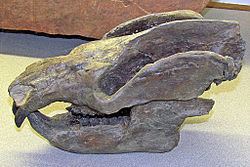Clade Chiniquodontoidea Phylum Chordata Order Therapsid | Scientific name Prozostrodontia Higher classification Chiniquodontoidea | |
 | ||
Clade ProzostrodontiaLiu and Olsen, 2010 Lower classifications Mammal, Bear, Opossum, Squirrel, Hamster | ||
Prozostrodontia is a clade of cynodonts including mammals and their closest non-mammaliform relatives such as Tritheledontidae and Tritylodontidae. It was erected as a node-based taxon by Liu and Olsen (2010) and defined as the least inclusive clade containing Prozostrodon brasiliensis, Tritylodon langaevus, Pachygenelus monus, and Mus musculus (the house mouse). Prozostrodontia is diagnosed by several characters, including:
Prozostrodontia includes tritylodontids, which have traditionally been placed within the more primitive cynodont group Cynognathia as distant mammal relatives. It also includes Tritheledontidae, which has long been placed close to mammals. Most previous studies considered Tritheledontidae a valid monophyletic grouping, meaning it was a true clade including all the descendants of a single common ancestor, but Liu and Olsen (2010) found Tritheledontidae to be a paraphyletic series of basal prozostrodontians. Below is a cladogram from Liu and Olsen (2010) showing the phylogenetic position of Prozostrodontia:
